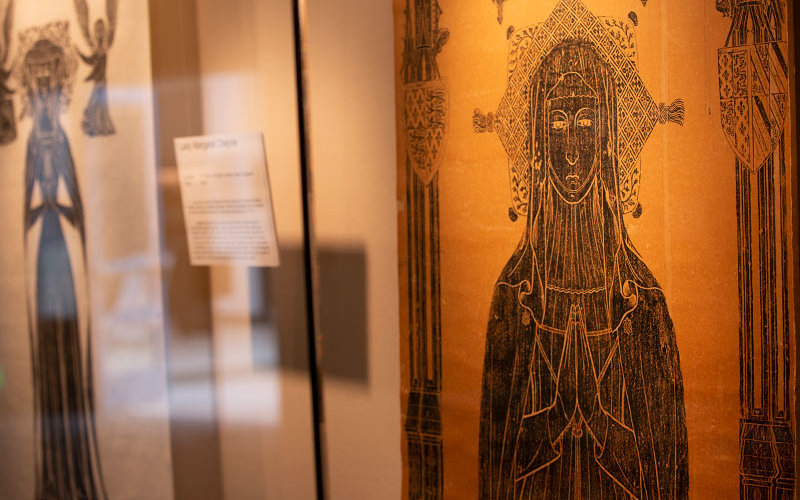
Throughout history, family and friends have attempted to memorialize their dead with images and likenesses. From the 13th through the 17th century, those images developed from stone or wood effigies to monumental brasses.
“They were created to commemorate the dead and to ask for prayers for the souls of the deceased,” explains Cal State Fullerton history graduate student Gareth O’Neal, who has been interested in the Middle Ages since he was young. “They marked not only the site of the deceased but the person’s status, place in society. Though they were popular throughout Europe, they were most popular in England.”
O’Neal is curator for a new exhibit in the university’s Pollak Library, “Lords and Ladies in Black and White,” which highlights the creation of the brasses and the once popular hobby to create rubbings, or copies, with colored wax over paper laid atop the etchings.

While at one time there were 250,000 such monumental brasses, says O’Neal, only about 8,000 remain. And because of their fragile nature, rubbings of those that still exist were stopped. “That makes these rubbings from the original tombs a rare resource on England during the Middle Ages and the Renaissance.”

The CSUF exhibit features replicas of brasses, rubbings, books on the brasses and other related items, including rubbings from the collection of the late Roberta F. “Bobbe” Browning, director emeritus of career development and counseling at CSUF. The items were donated to the university by her husband, Lee Broadbent.
The exhibit has special meaning for O’Neal, who has earned bachelor degrees in comparative literature and French, as well as a master’s degree in English from Cal State Fullerton. He was attending a class taught by Ellen Caldwell, associate professor of English, comparative literature and linguistics, when he saw his first rubbing, that of Sir Robert de Septvans.
“It was stunning. Here was this centuries-dead knight in front of me, half a world away from his homeland, in a time so far removed from anything that would have seemed familiar to him,” he remembers. “It was from that that I was made aware of the somber beauty of these funerary monuments.”

He would collaborate with Caldwell on cataloging and researching the 52 rubbings from the Browning Collection until the educator’s death in 2018. O’Neal continued the work and the exhibition grew from that project and is O’Neal’s M.A. in history project. He is slated to graduate in January 2020.

“Lords and Ladies in Black and White” also includes items from the collection of Dolores Roche, who discovered brasses while living in Belgium. Rubbings that she made from those brasses followed her throughout her travels and back to the U.S. where she purchased replicas to demonstrate her hobby to friends and her elementary school students.
The exhibit continues through Sept. 20 in the Salz Pollak Atrium Gallery of the Pollak Library. As part of the exhibition, there will be a July 27 Brass Rubbing demonstration from noon to 4 p.m. in Room 130 of the Pollak Library. Additional inormation available on the library website.